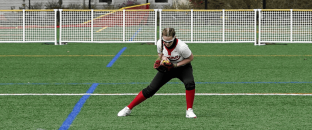*Note: products listed on Bases Loaded Softball are selected by our softball players, coaches, and team of enthusiast writers and editors. Buying softball products through our links may earn us a commission with no additional cost to you.
The rise ball is often considered to be one of the most difficult pitches to master. This is why many coaches choose to save teaching this pitch for absolute last—after the fastball, changeup, drop ball, curveball, drop curve, and screwball.
The reason why a rise ball is so difficult is because you’re working against gravity. Anytime you throw the ball, gravity is going to be pulling it towards the ground. This is what makes a drop ball so much easier than a rise ball. With a rise ball, you’re trying to get the ball to defy gravity.
If you do succeed in making the ball rise, you’ll probably have a better chance than any other pitch at striking out the batter. But if you don’t succeed in making the ball rise, you’ll probably be giving the batter a fairly easy shot. In other words, the rise ball is a high-stakes pitch that is a huge risk, but if executed correctly offers a similarly huge reward.
This is why it’s so important to learn the correct rise ball technique. Below, we’re going to show you how to throw a rise ball in softball.
What differentiates a rise ball from other pitches?
Often, a pitcher thinks they’re throwing a rise ball when really they’re just throwing a high fastball. The differentiating factor between the rise ball and other pitches where the ball moves in an upward trajectory is that the rise ball start by moving forward, then roughly 8-10 feet before reaching the plate makes a sharp upward curve.
The idea here is to make the batter believe they’re getting an easy pitch straight down the middle, then change it up on them at the last moment. If done correctly the batter will swing down the middle, while the ball curves up and over their bat. Or, if the batter does his the rise ball, it will likely be a pop up that’s easy to catch.
How to throw a rise ball in softball (perfecting your form)
There are five major factors that will determine your ability to successfully execute the rise ball: grip, stride, posture, release, and followthrough.
Grip: Your grip will largely depend on your unique hand shape and size. Many players find success with the “C” grip, where your top four fingers and thumb create a C shape around the ball, or the four seam fastball grip, where the seams are running horizontally rather than vertically.
Stride: When throwing a rise ball, you need to have a long stride. By making your stride longer, you will also be lowering your body further down than normal, allowing you to release the ball slightly lower. You should feel your hand getting somewhat close to the ground as you reach the low point in your throw before release.
Posture: Before your release, you’re also going to want to make sure you have the right posture. Remember the saying “where the head goes, the body follows.” In other words, where you position your head is a major factor in where the ball goes upon release. For rise balls, this means it’s helpful to lean your posture back so your head and shoulders are pulled backwards as you’re letting go of the ball. If you’re tilted back like this so that your head is facing the sky, the ball will have a better chance of moving upwards towards the sky too.
Release: This is one of the most important parts of the pitch. If you’re a right handed pitcher, now is when you should concentrate on facing your hand towards third base. If you’re a left handed pitcher, you should concentrate on facing your hand towards first base. In both cases, you should quickly spin your hand back upon release. The hand motion should be like turning a doorknob, just as you release the ball. This will give the ball the backspin it needs to rise.
Follow through: As you release the ball, finish with your throwing hand high and index finger pointing towards the sky.
How do you throw a riseball in softball? Use these drills.
Now that you’ve got your form down, it’s time to start learning some methodology and training drills to really perfect your rise ball. The first thing you need to learn is how to perfect the back spin on you need to put on the ball upon release.
Remember, when learning a new skill like the rise ball, it’s important to always start off slow, perfect your technique, then start practicing at full speed. If you start at full speed right away, it will be more challenging to perfect your form, and will ultimately take longer to learn, while possibly forming bad habits along the way.
Best rise ball drills:
Drill #1: Start in the open position, and with somebody standing across from you ready to catch the ball and a coach close to you, watching your hand closely. Grip the ball as detailed above in the “grip section.” Then, simply throw the ball to the person across from you, while trying to put as much backspin on the ball as possible. At this stage, don’t worry about throwing the ball super fast—you’re just trying to perfect the backspin. Keep throwing the ball back and forth with the person across from you, practicing your backspin. Meanwhile, have your coach—or someone who’s familiar with the proper rise ball form (even if they’ve just gone over the technique listed in this article)—watch your hand closely to make any corrections to your form. If your form needs correcting, do so, then continue throwing the ball back and forth until you feel confident in your back spin form.
Drill #2: Kneel on your back knee, so that your front leg is up outstretched in front of you with your foot planted on the ground. This should make it so that your body is already leaning backwards, in a similar form to how you would want your body to be positioned when throwing a rise ball while standing. The point of kneeling is to ensure your weight is automatically towards the back, so you don’t have to worry about maintaining that form, and you can just focus on perfecting your release.
Now that you’re kneeling in this form, start practicing your rise ball pitch. Throw the ball back and forth with a catcher 25 times. Execute this drill every other day.
Drill #3: Put up a rope that is about 3-4 feet off the ground (depending on the height of the pitcher), and 8 feet in front of the home plate, running horizontally. Then, set up another horizontal rope behind the home plate, but this time, make sure it’s 4-6 inches higher than the first rope.
Once your ropes are set up, the objective is to pitch the ball under the first rope, and above the second rope. If you can pull this off, it means you’ve just thrown a successful rise ball. This is a very difficult drill, so if you’re not having any success, feel free to adjust the ropes to make the pitch easier.
You can set up these ropes using any kind of stick shape object (metal rods, broom poles, wooden fence posts, etc.)
Drill #4: Start with normal rise ball practice: stand across from a catcher, and throw the ball back and forth, trying to pitch a rise ball every time. Gradually work your way back to twice the distance you would normally stand away from the catcher, and keep trying to pitch rise balls. The theory behind this is similar to practicing pull-ups with a weighted vest—you increase the amount of resistance, and grow accustomed to it, so that when you try to pitch a rise ball at a normal distance it seems effortless. This will also help you improve your posture and technique.
When can you expect to perfect the rise ball?
Like anything difficult, the rise ball is a pitching technique that requires lots of repetition to learn properly. The more you practice this pitch, the faster you will learn how to execute it. When you are finally confident to use it in gameplay, start out by only using it when you’ve already gotten two strikes on the batter.
So get out there and practice, practice, practice! Now that you have your pitching perfected, why not check out some more drills and learn how to slide in softball like a pro!








